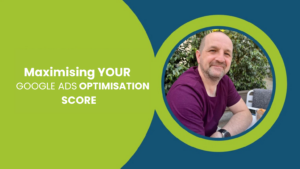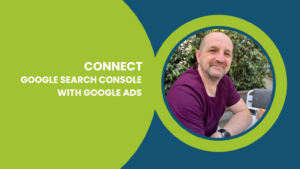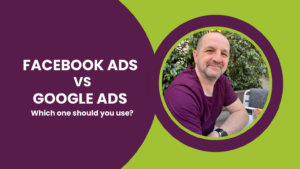The competition grows increasingly fierce for law firms. Digital technology continues to break down the geographical barriers between businesses and prospective clients. Law firms now compete with one another on a more national, and global, scale. Therefore, law firms need an aggressive growth strategy, requiring a strong pipeline of new clients, referrals, and repeat business.
Needless to say, strong and robust digital marketing strategies are needed to achieve this. Having strong branding is one thing, but it is crucial to be able to deliver a consistent stream of high-quality business opportunities to your website.
When it comes to doing this, there are an abundance of strategies you can adopt. SEO, technical SEO, PPC, email marketing, print media, and much more. In this blog, we’ll be outlining the most impactful strategies you can implement and our tips on how you can use them to market your law firm.
Steps to Promote your Law Firm Online
Firstly, one of the reasons why people get intimidated by the thought of marketing for law terms is that a lot of buzzwords and terms are thrown around — often without any definitions. Don’t worry, we’ve put together a complete glossary of SEO and other marketing terms; feel free to keep this open while reading through this guide!
At a broad glance, creating a successful integrated marketing strategy can be boiled down to these simple steps:
- Clearly define your target audience – Who exactly are you targeting? Why?
- Choose the platform(s) that best suit your audience – where do they like to engage with content? When will they be looking for services? Where is your audience?
- Create ads for each stage of the funnel – the best campaigns are the ones that are integrated, featuring ‘multi-touch’ approaches. Consider the scope of your law firm and the clients you want to work with.
- Configure campaign targeting – for your paid options, keep it relevant and targeted.
- Create an awesome landing page and A/B test to maximise performance and ROI – great campaigns and content, both from a paid and organic perspective, are worthless if you don’t have a well-functioning site that can convert well.
- Implement tracking – you can’t measure what you don’t track. Effective tracking is needed so you can make informed decisions to optimise campaign performance.
Law Firm Marketing Strategies Using Google
Get Your Personal Google Ads Audit Video
Please provide your details below and one of our specialists will be in touch as soon as possible.
There are numerous versions of the marketing funnel. For this strategy, let’s consider a simple, three-stage funnel.
Stage One: Awareness and Interest (Top of Funnel)
To create demand, your audience must first be aware of your law firm.
This first stage of any marketing strategy aims to create awareness, create interest and stimulate desire. For example, a lawyer promoting their firm’s niche legal services might target an audience to create awareness of what they can provide. It’s unlikely that a prospective client will click the advert and enquire immediately, but we can expect the prospective client to form their initial impressions of the firm and its services. This is impacted by the branding, site experience, values communicated, trust built, and more. This then persists as they explore your competitor’s solutions too and weigh everything up.
Stage Two: Desire
With a better understanding of their requirements, they might have considered your services to be the best fit for them. They’ll return to your website, or other channels, with a more refined goal of what they need to discover. For example:
What do your services cost?
What is your availability?
What information is required to proceed?
As a solicitor, it can be difficult to provide on-page clarify on these things as they’ll often vary. But, nonetheless, it’s best to make it easy for your prospects to find this information and keep them interested in pursuing your services.
Stage Three: Conversion
This is where prospects take direct action and enquire with you.
Now that we understand the three-stage funnel, let’s explore the opportunities to market law firms using Google.
Law Firm Awareness Marketing Campaigns
Taking the individual Google platforms in turn, let’s first start with the top-of-funnel campaigns, focusing on the goals of interest and awareness.
How to Promote Your Law Firm Online With YouTube Video Ads
YouTube Location Targeting
Firstly, a great thing to consider is audience targeting. Location is most likely a crucial component in your law firm targets a local area as opposed to more national or global efforts. Google Ads (used to also create and manage a YouTube Ads campaign) provides the functionalitity to target users;
- Within a radius of your law firm – e.g. 20 miles
- In a specific town or city
- Within specific postcodes
It wise to take extra caution with location targeting as it isn’t as accurate as some other ad platforms. Pro tip: take care to target “people in, or regularly in” your target locations, rather than “people who have shown an interest in” your target location.
YouTube Demographic Targeting
As another layer of targeting, it’s great to consider demographics to more accurately reach your target audience for your campaign. Within your YouTube Ads campaign, it’s a good idea to target specific ages, genders, parental statuses and, in some countries, target by household income, and more.
This also provides a useful opportunity to unpick and understand your target audience further.

A word of warning for demographic targeting, however: there is a high percentage of users who fit into the “unknown” section of each category.
Consider that there are potentially thousands or hundreds of thousands of 35-44-year-olds in the “unknown” section. If this is your target audience for your legal services campaign, you should heavily consider including “unknown” in your targeting options. If you only choose to target 35-44, you could be missing out on big portion of your target audience.
It is also recommended to exclude the demographics that you definitely do not want to target. However, whichever demographics you choose, remember to monitor and optimise the performance for those age groups to maximise the return of your campaign. Great campaigns are monitored regularly, allowing for considered and proactive adjustments.
YouTube Interest Targeting
Additionally, you can also target your audience based on their interests, too. There are a wide range to choose from, allowing you to get very specific for your campaign requirements. For example, you might see these audience segments when setting up your law campaign;
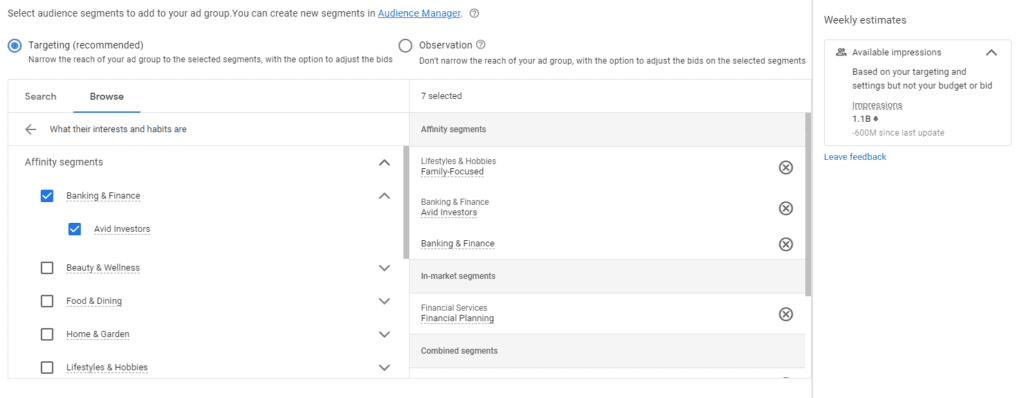
We have a blog on Affinity Audiences vs In Market Audiences to provide a better understanding of the two different categories, but as the image shows, there are predefined Audiences in the market for interests such as Banking & Finance and further behavioural breakdowns such as Avid Investors. It’s also worth noting that when selecting these targeting options, members of any of those listed could see your ad, e.g. users don’t have to be in all categories, only one of them.
Rather than, or in addition to Audience Targeting, you might consider Topic targeting. Topic targeting means that we’re now targeting Content about the topic – videos about it, rather than a user’s interest in it.
With Topic targeting, we’re limiting ads to show only alongside banking and finance videos. However, someone interested in banking and finance doesn’t only spend their screen time watching only fitness videos, so this strategy might be limiting if you’re not careful.
If the Audience Targeting and Topic Targeting are both used in your campaign, they’re combined – users would only see your video ad when they match the interest targeting and are watching a video which matches the Topic target too – that makes the targeting very narrow and specific.
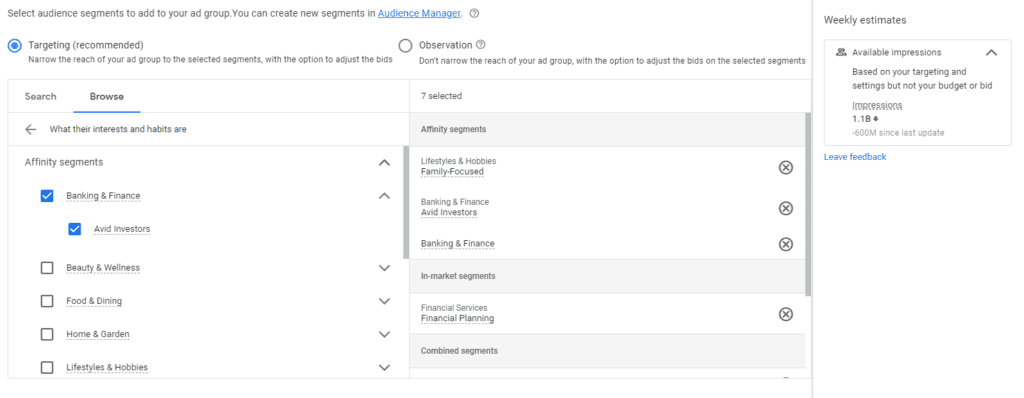
YouTube Placement Targeting
Furthermore, you could target specific YouTube Channels and/or specific YouTube videos – this is called Placements.
This is really niche targeting and should be used carefully. Remember, this targeting combines with Location targeting. Targeting users within a 20mile radius who watch a specific YouTube channel is likely to produce a very small reach for your video ad, especially when you consider that your ad won’t show every time your targeting is matched. You’re up against other advertisers targeting this same user, the same channel or the same video using the same or other targeting methods.
In all, it’s probably best to avoid the Placement targeting option unless you are also targeting a large geographic area and/or are targeting hundreds of channels and videos.

YouTube Keyword Targeting
Finally, there is also keyword targeting (see keyword research). Here, you can choose keywords which match videos a user is watching might relate to. This could easily overlap with Topic targeting, or Placement and again is targeting the content rather than the user.
Keyword targeting could be a much broader way of targeting content or a strategy to expand targeting with an existing campaign.

YouTube Campaign Device Targeting
Next, we can choose which devices we want our YouTube video ads to show on. This is segmented into mobile, tablet and desktop. As we’re looking for audience reach and awareness with a YouTube campaign, you’ll most likely want to leave this as all devices, but you might consider excluding some devices for marketing to certain audiences.
YouTube Video Ads – Success or Failure
The last part is arguably the most important, or at the very least, critical to the performance and ROI of your campaign: Your Ad(s). The videos you promote will determine how great (or poor) the response is from your campaign.
Examples of awesome YouTube Law Firm Ads
The Brough Law Firm TV Commercial

Downs Collins, P.A. Legal Video Marketing

Berry Law Firm

To Summarise the YouTube Ads Opportunity for Your Law Firm
- YouTube Ads is a Top of Funnel Opportunity to create awareness and interest within a geographic location and among audiences with relevant interests
- You pay for views or for clicks and you’ll limit your campaign spend by day, week or duration
- The ad/video itself is a critical component and arguably has the greatest impact on campaign performance and ROI
Promoting a Law Firm Online with Google Display Ads
Google Display Ads Location Targeting
A Google Ads Display Campaign targets users across Google’s enormous Display Network.
“The Google Display Network is the #1 global display ad network, reaching over 90% of internet users worldwide, with more than a trillion impressions served to over 1 billion users every month.”
As with YouTube Ads, audience targeting is the starting point for Google Display campaigns. Location is most likely important if yours is a local law firm. A Google Display campaign provides the opportunity to target users;
- Within a radius of your law firm – e.g. 20 miles
- In a specific town or city
- Within specific postcodes
Take care with location targeting though, it isn’t as accurate as some other ad platforms. Also take care to target “people in, or regularly in” your target locations, rather than “people who have shown an interest in” your target location.
Google Display Ads Demographic Targeting
Now we know where your audience is, we need to consider demographics. Within your Google Display Ads campaign, you could decide to target specific ages, genders, parental statuses and in some countries, target by household income.

A word of caution on demographic targeting: there is a high percentage of users who fit into the “unknown” section of each category.
Consider that there are potentially thousands or hundreds of thousands of 35-44-year-olds in the “unknown” section – if that’s your target audience, you may want to include “unknown” in your targeting options. If you only choose to target 35-44, that will miss out on a big chunk of your target audience.
I would also consider that excluding the age groups or genders you definitely don’t want to target might often be the best option. Whichever you choose, remember to monitor and optimise performance for those age groups to maximise the return of your campaign.
Google Display Ads Interest Targeting
In addition to location targeting, you should then consider audience interests. There are plenty to choose from, depending on your law firm. Using our previous example;

See Affinity Audiences vs In Market Audiences to understand the two different categories, but as the image shows, there are predefined Audiences in the market for running apparel or marathons, and also with an Affinity (interest) in Sports and Fitness. Remember, when selecting these targeting options, members of any of those listed could see your ad, e.g. users don’t have to be in all categories, only one of them.
Rather than, or in addition to Audience Targeting, you might consider Topic targeting. Topic targeting means that we’re now targeting Content about the topic – web pages about that topic, rather than a user’s interest in a topic.
With Topic targeting, we’re limiting ads to show only alongside running or fitness content – blog posts, news items etc. Needless to say, a running enthusiast doesn’t only spend their screen time reading just fitness blogs, so this strategy might be limiting if you’re not careful.
If the Audience Targeting and Topic Targeting are both used in your campaign, they’re combined – users would only see your ad when they match the interest targeting and are visiting a web page which matches the Topic target too – that makes the targeting very narrow and specific.
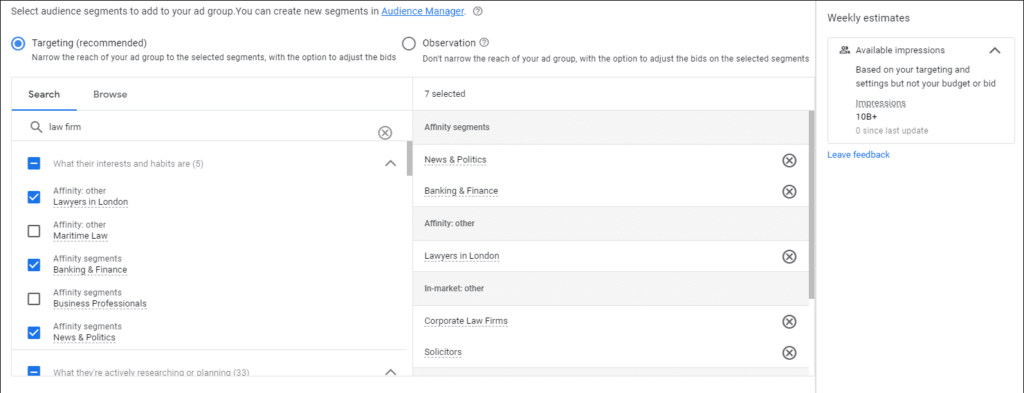
Google Display Ads Placement Targeting
Furthermore, you could target specific Websites and/or specific Web Pages – this is called Placements Targeting.
This is really niche targeting and should be used carefully. Remember, this targeting combines with Location targeting. Targeting users within a 20mile radius who visit a specific website or specific web pages is likely to produce a very small reach for your ads, especially when you consider that your ads won’t show every time your targeting is matched. You’re up against other advertisers targeting this same user, the same websites or the same web pages using the same or other targeting methods.
In all, it’s probably best to avoid the Placement targeting option unless you are also targeting a large geographic area and/or are targeting hundreds of websites and web pages.

Display Keyword Targeting
Finally, there is also keyword targeting (see keyword research). Here, you can choose keywords which match the pages a user is visiting. This could easily overlap with Topic targeting, or Placement targeting and again is targeting the content rather than the user.
Keyword targeting could be a much broader way of targeting content or a strategy to expand targeting with an existing campaign.
Using our law firm example again, we might target keywords such as “court lawyers”, “legal help”, “hire lawyer”, “law services”, “legal help” etc.

Google Ads Display Campaign Device Targeting
Next, we can choose which devices we want our display ads to show on. This is segmented into mobile, tablet and desktop. As we’re looking for audience reach and awareness with a Google Ads campaign, you’ll most likely want to leave this as all devices, but you might consider excluding some devices for marketing some law firms.
Google Display Ads – Success or Failure
The last part is arguably the most important, or at the very least, critical to the performance and ROI of your campaign: Your Ad(s). The ads and the videos you promote will determine how great (or poor) the response is to your campaign.
In Display Campaigns, the ads you can use are both banner ads in different formats, but also video ads – yes, the same as those you might be using for your YouTube campaigns!
Examples of Awesome Display Law Firm Ads:
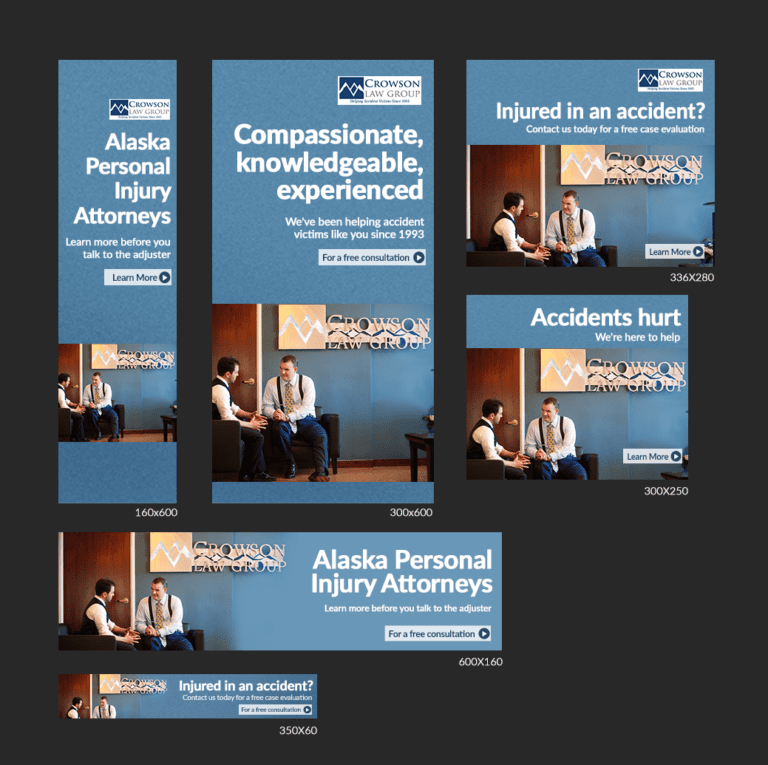
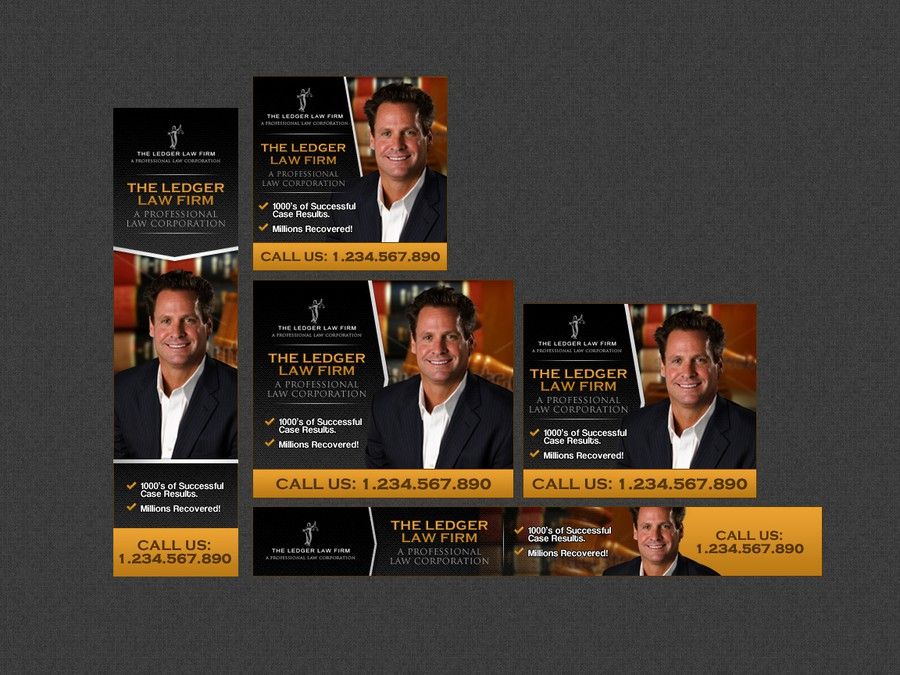
To Summarise the Google Display Ads Opportunity for Your Law Firm
- Google Display Ads is a Top of Funnel Opportunity to create awareness and interest within a geographic location and among audiences with relevant interests
- You pay for impressions (CPM) or for clicks and you’ll limit your campaign spend by day, week or duration
- The ad/video itself is a critical component and arguably has the greatest impact on campaign performance and ROI
Popular Google Ads Videos
Law Firm Search Marketing Campaigns
In this section, we’ll focus on mid-funnel campaigns, focusing on the goals of meeting an existing desire.
Promoting a Law Firm Online Using SEO
Search Engine Optimisation (SEO) is a great way to get free traffic and create awareness of your firm. An Event SEO Campaign represents the mid-funnel of your Event Marketing Strategy.
Before you embark on SEO as an Law Firm Marketing Strategy, you will need to consider whether there is enough time to get pages ranked on Google before your event comes around. SEO can be competitive and challenging and take time to create and rank content – but not always. It pays to consult with a Law Firm SEO Agency to establish whether there are some quick wins for your SEO.
Within Search, there is a smaller version of the funnel – let’s call it the “Search Funnel”.
Stage One: Desire
In the first stage of the search funnel, we’re targeting search terms users might use who are not yet aware of your law firm, but who are interested in the content of your firm, or who are interested in the problems it might solve.
Using our running event example, we might complete keyword research and target keywords such as;
- Law Firm Portsmouth
- Legal Services Portsmouth
- Legal Help Portsmouth
- Legal Website
- (Of course, use the location of your Law Firm!)
Stage Two: Brand Search
In this phase of the search, we’re targeting users searching for the firm itself. This audience is already aware of your law firm from your Awareness Campaigns, when it is and what it’s called – they’re either ready to register or to buy tickets, or they’ve been recommended by a friend.
Provided you’ve got the basic SEO right, your pages should surface in the first position on Google for those very specific searches
- The name and location of your law firm
- Your firm’s opening and closing times
- The type of law firm and the location (again, provided it’s unique and there’s not too much competition)
Whilst your site and pages should rank automatically for these searches, it’s well worth checking and monitoring to make sure. This phase is critical – if you invested in those top-of-funnel campaigns to create awareness, interest and desire, but your law firm can’t be found through search, you’ll miss out on clients.
Principles of SEO for Law Firms
SEO is a deep and complex subject, but let’s focus on the basics for ranking for those keyword examples;
On-Page SEO: Make sure that your target keyword is included in the Page Title, the page Meta Description and the H1 Tag on your page and that it’s included in the body test too.
Since you know your and its content, you’ll naturally include semantic content around the subject too.
Technical SEO: Make sure your website and the page you’re trying to rank can be indexed by Google. Open Google Search Console and check that your page is indexed, or request indexing and address any issues you see there.
If the page is important, make sure it’s included in the navigation of your site so that humans can easily find it and search engines know it’s important too.
Make sure you only have one page that you’re optimising for the keyword(s). If you have two pages with similar content, that could cause confusion and harm your rankings. Technical SEO can be a real headache, so if your site is built with WordPress, we’d recommend consulting an expert WordPress SEO agency to get help on this.
Link-Building: Links from external sites will help get your page found and indexed, and will also signal to Google that the page is important too – which helps it rank for your target keyword. Get your event listed on local news websites (ideally with a link to your page) and share it on social media platforms too. Social Media links aren’t as valuable as links from news sites, but they’re still worth placing.
Using Google Business Profile to Promote your Law Firm Online
Google Business Profile is not only a fantastic tool to help showcase your business in search engine results, but it can also be used to promote law too. Event posts allow you to communicate directly with your customers to show them interesting events you are planning on hosting, and they can create more engagement depending on how you choose to build your post, whether you use images, videos or CTA buttons.

How to Post Updates to Your Google Business Profile

Recent Google Ads Blog Posts
After putting your firm onto your Google Business Profile, you can then use GBP to post information or to further promote your firm over time, to do this you simply need to navigate to the posts section in the left hand menu. From here you’ll have to option to post offers, events, products and updates with the what’s new section. We would advise using the what’s new section to post updates on your law firm, you can photo’s, text and CTA’s.
Here at Tillison Consulting, we provide a range of digital marketing services for a variety of different business sectors. If you’re looking for digital marketing services for Law Firms such as SEO for Law Firms, PPC for Law Firms and Google ads for Law Firms.


